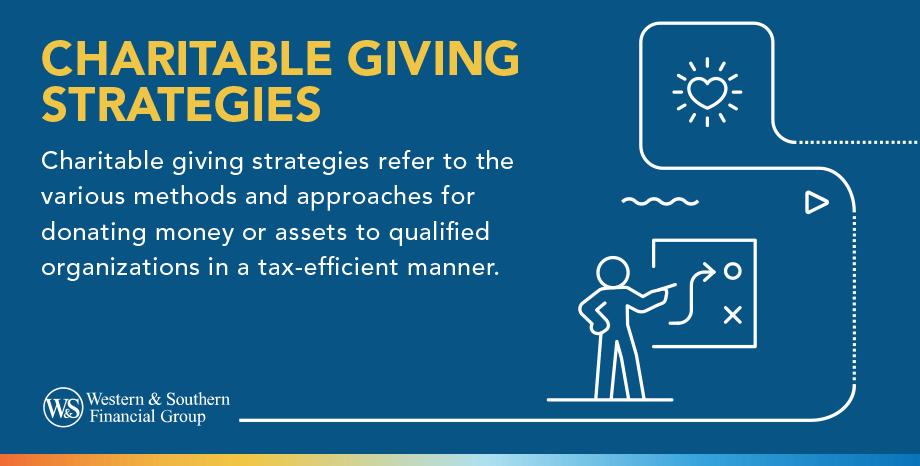Table of Contents
Table of Contents


Key Takeaways
- Charitable giving offers several benefits, including tax deductions, personal fulfillment, and creating a lasting impact by supporting causes aligned with one's values.
- Consider charitable giving strategies like donation deductions, donor-advised funds, remainder trusts, qualified distributions, and philanthropic planning - each has pros and cons.
- Charitable giving involves aligning donations with personal values and long-term goals to maximize the impact of contributions and potentially gain tax advantages.
- For successful charitable giving, identify goals/values, assess finances, select suitable vehicles, work with advisors, and monitor/adjust strategy as needed.
- For retirees, strategies like IRA charitable distributions, gift annuities, and legacy planning offer tax benefits while supporting causes and leaving an impact.
What is Charitable Giving?
Charitable giving involves donating money, goods, or services to nonprofit organizations or individuals in need. It is a cornerstone of many financial plans, allowing individuals to support causes they care about while potentially benefiting from tax deductions and charitable deductions. It is vital in addressing social, environmental, and humanitarian issues worldwide.1
There are several ways to engage in charitable giving, each with benefits and considerations. Some common methods include:
- Cash Donations: Monetary gifts are a simple way to give to your favorite charities, religious organizations, schools, or community foundations.
- In-Kind Donations: Instead of cash, individuals may choose to donate goods or services. This could include clothing, food, vehicles, or professional expertise.
- Bequests: Estate planning allows individuals to donate a portion of their assets to charity upon their death, creating a lasting legacy while potentially reducing estate taxes.
- Volunteerism: Giving back doesn't always involve money. Many organizations rely on volunteers to support their missions through hands-on work, mentorship, or advocacy.
Whether through financial contributions to charities over time or volunteering, individuals have the power to make a meaningful difference in the world through charitable giving.
Importance of Charitable Giving and Its Benefits
Charitable giving holds immense importance for several key reasons:
- Empowering Lives: Your donations can help provide vital support to those facing poverty, illness, and lack of access to education, empowering individuals and communities in need.
- Tax Benefits: Charitable giving offers tax advantages and taxable distributions, allowing you to lower your taxable income while making a positive impact.
- Community Upliftment: Local organizations work tirelessly to address issues and improve the overall well-being of communities, strengthening the fabric of society.
- Aligning with Your Values: Donating enables you to actively support causes that resonate with your beliefs and principles, from environmental conservation to medical research and social justice.
- Leading by Example: Your generosity inspires others, especially the younger generation, to embrace a spirit of compassion and community-mindedness.
- Fostering Connections: Charitable activities help provide opportunities to connect with like-minded individuals, building a network of support and camaraderie.
- Promoting Well-being: Acts of giving have been shown to boost happiness, reduce stress, and contribute to improved mental health and overall well-being.
- Catalyzing Change: Charitable organizations tackle systemic issues at their roots, driving long-term, sustainable change that transforms lives and communities.
- Strategic Impact: Donating appreciated assets like stocks or real estate offers significant tax advantages while amplifying the impact of your contributions.
- Purposeful Legacy: Aligning your philanthropy with personal values and long-term goals magnifies your impact, ensuring each donation serves a greater purpose and leaves a lasting legacy.
Charitable giving maximizes financial benefits, drives meaningful change, and leaves a legacy aligned with personal values and aspirations.
Did You Know?
$499.3 billion was donated in 2022 from various sources, including individual donors, corporate entities, foundations, and bequests.2
Example of Impactful Charitable Giving
Imagine Melinda Gates' investment in mosquito nets. It was reported in 2005 that she championed the idea of distributing insecticide-treated nets across Africa. This seemingly simple intervention was a game-changer. Malaria, a deadly mosquito-borne illness, was ravaging the continent.3
The nets provided a barrier, protecting millions of families from getting sick. Gates' generosity, combined with strong public health efforts, led to a dramatic drop in malaria deaths. This is just one example of how well-directed charitable giving can have a powerful, life-saving impact.
10 Types of Charitable Giving Strategies
Let's explore different charitable giving strategies for individuals who want to make a difference.
1. Donation Tax Deductions
A donation tax deduction is a government incentive for charitable giving. By donating to qualified public charities, you can lower your tax bill while supporting causes you care about—a win-win for both donors and charities.
2. Donor-Advised Funds (DAFs)
A donor-advised fund (DAF) allows tax-deductible charitable donations with donor control, akin to a personalized charitable savings account. It streamlines philanthropy management, potentially enabling tax-free growth and creating lasting community impact.
3. Charitable Remainder Trusts
A Charitable Remainder Trust (CRT) enables you to support causes and meet financial goals by transferring assets, earning income, and donating the remainder to charity after your passing, providing tax benefits and a meaningful legacy.
4. Charitable Lead Trusts
A Charitable Lead Trust (CLT) supports charities and tax savings by transferring assets to a trust that pays to charity for a set period. Later, the remaining assets pass to beneficiaries, offering a tax-efficient method to leave a legacy.
5. Qualified Charitable Distributions
A Qualified Charitable Distribution (QCD) enables retirees aged 70½ or older to transfer IRA funds directly to a charity, fulfilling their required minimum distribution (RMD) without increasing taxable income. This strategy supports charities and may lower income taxes, making it advantageous for charitable giving and estate planning.
6. Philanthropic Planning
Philanthropic planning integrates charitable giving into wealth management strategies, enabling individuals to leave enduring legacies, gain tax advantages, and honor personal values.
7. Legacy Giving
Legacy giving also called planned giving, is the strategic allocation of assets to beneficiaries or charities after death, ensuring lasting impact through continued support and values. It often involves wills, trusts, and life insurance policies to organize asset distribution according to personal wishes.
8. Impact Investing
Impact investing combines financial returns with positive social or environmental outcomes. Investors aim for profit and purpose simultaneously to make a meaningful impact while growing wealth.
9. Corporate Giving Strategies
Corporate giving strategies involve supporting charitable causes through donations, volunteer programs, matching gifts, and sponsorships, enhancing brand reputation and employee morale while fulfilling social responsibilities.
10. Charitable Gift Annuities
A Charitable Gift Annuity is a donation to a charity that helps provides a lifetime income stream, tax benefits, and financial security in retirement.
Steps to Implement Charitable Giving Strategies
To donate effectively, plan and evaluate the impact on causes. Maximize benefits for recipients and the community. Here are the key steps to help you.
Step 1: Identify Your Goals and Values
When choosing your charitable priorities, reflect on your passions and experiences, assess community needs, and consider the lasting impact of your donations. This helps clarify your goals and values, shaping a giving strategy that aligns with your passions and creates significant change.
Step 2: Evaluate Your Financial Situation
Assess your financial situation, evaluate philanthropic goals, and work with an expert to create a charitable giving strategy that aligns with your budget and long-term objectives. Continuously review and adjust as needed for maximum impact.
Step 3: Choose the Right Charitable Vehicles
When making charitable donations, it's important to choose a vehicle that aligns with your goals and financial situation. Consider direct cash donations, donor-advised funds, charitable trusts, private foundations, and charitable gift annuities.
Step 4: Work with Professional Advisors
Professional advisors offer valuable guidance and expertise in charitable giving strategies, providing legal, tax, and investment advice to align contributions with financial goals and maximize tax benefits. Collaborating with these experts helps create a tailored plan to optimize philanthropic impact and support long-term financial objectives.
Step 5: Monitoring and Adjusting Your Strategy
To ensure that your charitable giving is aligned with your goals and financial situation, follow these tips:
- Regularly review your finances.
- Track the impact of your donations.
- Evaluate tax implications.
- Stay flexible and adjust your strategy as needed.
By monitoring and adjusting your charitable giving strategy, you can ensure that your donations make a meaningful impact while supporting your broader financial goals.
Life Insurance in Charitable Giving
Life insurance is a useful tool for charitable giving that helps provides tax benefits. Including life insurance in philanthropic plans can help provide tax advantages and leave a lasting legacy. Some ways to use it for charity include:
- Naming a Charity as a Beneficiary: Naming a charity as the beneficiary of a life insurance policy can help provide financial support after the policyholder's death.
- Donating a Policy: Donors can donate a life insurance policy to a charity and may get a tax-itemized deduction for the policy's fair market value.
- Creating a Charitable Remainder Trust: You can fund a charitable remainder trust with a life insurance policy to get income for a set period and donate the remaining assets to charity.
- Utilizing a Donor-Advised Fund: This strategy involves funding a charitable remainder trust with a life insurance policy. The trust helps provide income for a period and the remaining assets go to charity.
Legacy Planning for Retirees
Retirees need to plan their legacies to distribute assets and securities according to their wishes, by passing on wealth to heirs tax-efficiently and leaving a lasting impact through charitable giving.
Retirement-Focused Charitable Giving Strategies
Donate appreciated assets like stocks, mutual funds, or real estate, use qualified charitable distributions from IRAs, or set up a donor-advised fund for tax-savvy charitable giving in your retirement plan. This strategy could also prove impactful for donors who are experiencing a high-income year.
Charitable Gift Annuities
Consider a charitable gift annuity to support your favorite charity while supplementing your income. You donate cash or property to a nonprofit organization, which helps provide fixed annual payments for life, with the remaining value going to charity when you die.
Tax Implications and Other Considerations
Consider these tax implications when making charitable donations:
- Tax Deductibility: Donate to eligible charities from your income taxes to reduce income tax deductions (limits apply based on AGI).
- Donating Appreciated Assets: Donate appreciated assets to avoid capital gains tax and get a charitable income tax itemized deduction based on the asset's fair market value.
- Qualified Charitable Distributions (QCDs): Retirees aged 70½+ can donate directly from their IRA to fulfill RMDs without increasing taxable income.
- Donor-Advised Funds (DAFs): You can donate to charity in future years while receiving a tax deduction for the current year.
- Bunching Charitable Contributions: Maximize tax benefits by bunching charitable contributions and exceeding the standard deduction threshold.
Consult a financial advisor or tax professional to optimize your tax situation.
Frequently Asked Questions
How do you maximize charitable giving?
What is the rule of thumb for charitable donations?
There isn't one definitive rule of thumb when it comes to charitable donations, but here's a breakdown of some common guidelines:
General Guidelines
- 10% of income: Some people follow the concept of tithing, or donating 10% of their income to charity. This is often rooted in religious traditions.
- 3% to 5% of income: This is a more moderate range that many people aim for if they want to be charitable without overly impacting their budget.
- The 50/30/20 Rule: This budgeting rule suggests spending 50% of your income on necessities, 30% on wants, and 20% on savings and debt. You could consider allocating a portion of that 30% towards charitable giving.
How can you give to a charity without using money?
Conclusion
Effective philanthropic planning can help you maximize your charitable contributions and leave a lasting legacy. It is recommended that you seek the advice of a financial advisor or a charitable giving professional to explore the best strategies that align with your goals and values. Start making a significant difference today!
Sources
- Charitable Contribution Deductions. https://www.irs.gov/charities-non-profits/charitable-organizations/charitable-contribution-deductions.
- Giving USA 2023: Donations Decline After Record Years. https://www.ruffalonl.com/blog/fundraising/giving-usa-2023-donations-decline-after-record-years/.
- Gates Foundation Commits $258.3 Million for Malaria Research and Development. https://www.gatesfoundation.org/ideas/media-center/press-releases/2005/10/gates-foundation-commits-2583-million-for-malaria-research.















